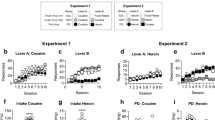Abstract.
Rationale: Under a progressive-ratio (PR) schedule, a subject must complete increasing fixed-ratio (FR) response requirements to obtain reinforcers. Response requirements are increased until responding stops; the final ratio completed being the "break point" and providing an index of the relative effectiveness, or value, of the reinforcer to maintain behavior. Objectives: This review examines the historical and conceptual framework underlying the PR procedure and examines the concept of relative reinforcer value. Pharmacological analysis (based on receptor theory), and behavior analysis (based on microeconomic theory) are reviewed. Methods: Using a microeconomic adaptation of the reinforcement model referred to as conservation, a mathematical model of PR performance is proposed based on the curvilinear relationship between economic supply and labor. Drug consumption and instrumental responding were assumed to reflect deviations from a balance point, defined as the levels of consumption and responding under no scheduled restraint. Data sets were re-analyzed in which several response sequences were examined in rhesus monkeys maintained on PR schedules of intravenous cocaine delivery. Results: The modified conservation equation fitted the PR data accurately, and results consistent with both linear and concave labor-supply functions were obtained. These results suggest that cocaine self-administration under PR schedules conforms to labor-supply relationships characterized as inelastic (consumption is resistant to increases in schedule requirements) and unit elastic (at high response costs, consumption declines with no corresponding increase or decrease in total responding). Conclusions: The labor-supply methodology allows for a definition of the relative value of a drug reinforcer in PR studies based on changes in consumption across response costs. Specifically, relative reinforcer value is defined in terms of changes in behavior from a balance point, rather than as a property that determines the strength of the instrumental response.
Similar content being viewed by others
Author information
Authors and Affiliations
Additional information
Electronic Publication
Rights and permissions
About this article
Cite this article
Rowlett, J. A labor-supply analysis of cocaine self-administration under progressive-ratio schedules: antecedents, methodologies, and perspectives. Psychopharmacology 153, 1–16 (2000). https://doi.org/10.1007/s002130000610
Received:
Accepted:
Issue Date:
DOI: https://doi.org/10.1007/s002130000610




